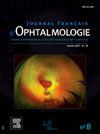Troubles musculo-squelettiques en ophtalmologie : quels facteurs de risque ? Quelles solutions ? Étude ergonomique dans deux cabinets français
IF 1.1
4区 医学
Q3 OPHTHALMOLOGY
引用次数: 0
Abstract
Selon la littérature internationale en épidémiologie, la prévalence des troubles musculo-squelettiques (TMS) du membre supérieur et du rachis est un phénomène d’ampleur chez les ophtalmologues. Cependant, peu d’études de cas cliniques explorent leur travail réel. L’objectif de ce papier est de donner à voir et discuter l’activité d’ophtalmologistes exerçant en consultation et en chirurgie, afin de mieux comprendre les éléments du travail à l’origine de leurs TMS, mais aussi les facteurs de protection et les leviers d’action. La méthodologie de recueil de données s’est appuyée sur des observations de consultations dans 2 cabinets privés (8 j) et à l’hôpital (0,5 j), des observations en blocs opératoires (3 × 0,5 j), des entretiens individuels (4 ophtalmologistes ; 4 orthoptistes ; 1 infirmière [IDE] ; 3 secrétaires médicales) et l’analyse de documents internes (données ressources humaines, plannings de consultations ou de chirurgie). Les facteurs de risques de TMS des médecins relèvent, d’une part, d’une inadéquation du matériel avec les contraintes de l’activité réelle (conception anthropométrique et agencement spatial), d’autre part de dimensions organisationnelles individuelles (ordonnancement des typologies de patients reçus sur la journée ou sur la semaine) et collectives (répartition des tâches et coordination entre secrétaires médicales, orthoptistes et médecins). Des actions de prévention sont possibles au niveau individuel (matériel utilisé, conception des espaces de travail, geste professionnel, conception des plannings), au niveau collectif (avec les autres membres du cabinet, avec la branche professionnelle). Les actions de prévention peuvent s’impulser soit en correction de situations existantes, soit dans le cadre d’un projet de changement.
According to international epidemiological literature, the prevalence of musculoskeletal disorders (MSDs) in the upper limbs and spine is a widespread phenomenon among ophthalmologists. However, few clinical case studies explore their actual work. The goal of this paper is to showcase and discuss the activity of ophthalmologists during office visits and surgery, to better understand the elements of their work that lead to MSDs, as well as protective factors and means of mitigation. The data collection methodology was based on observations of visits in two private practices (8 d) and at a hospital (0.5 d), observations in operating rooms (3 × 0.5 d), individual interviews (4 ophthalmologists; 4 technicians; 1 nurse; 3 medical secretaries), and analysis of internal documents (human resources data, consultation or surgery schedules). The risk factors for MSDs among doctors stem, on one hand, from a mismatch between equipment and the actual constraints of their activity (ergonomic design and spatial layout), and on the other hand, from individual organizational factors (scheduling of patient types received during the day or week) and collective factors (task distribution and coordination between medical secretaries, technicians, and doctors). Preventive actions are possible at the individual level (equipment used, workspace design, professional motions, schedule design) and at the collective level (with other members of the practice, with the professional branch). Preventative actions can be implemented either by correcting existing situations or within the framework of a project for change.
眼科肌肉骨骼疾病:哪些风险因素?解决方案是什么?两家法国公司的人体工程学研究
根据国际流行病学文献,上肢和脊柱肌肉骨骼疾病(MSD)在眼科医生中是一个普遍的现象。然而,很少有临床案例研究探索它们的实际工作。本文的目的是让咨询和外科眼科医生看到和讨论他们的活动,以便更好地理解导致他们的MS的工作因素,以及保护因素和影响因素。数据收集方法基于对2个私人诊所(8天)和医院(0.5天)的会诊观察、手术室观察(3 × 0.5天)、个人访谈(4名眼科医生);4名矫正医生;1名护士[IDE]3名医务秘书)和内部文件分析(人力资源数据、会诊或手术时间表)。msd的危险因素的不匹配的医生,一方面属于硬件设计与实际活动的约束(人体的尺寸和空间布局),另一方面是个体与组织(perspectives类型学上接收的患者上一天或一周(集体)和秘书之间的分工和协调医疗、orthoptistes和医生)。预防行动可以在个人层面(使用的设备、工作空间的设计、专业的姿态、时间表的设计),也可以在集体层面(与实践的其他成员、与专业部门)。预防行动可以通过纠正现有情况或作为改变项目的一部分来推动。根据国际流行病学文献,上肢和脊柱肌肉骨骼疾病(MSDs)的流行在眼科医生中是一个广泛的现象。然而,很少有临床案例研究探讨他们目前的工作。本文的目的是展示和讨论眼科医生在办公室访问和手术期间的活动,以更好地理解他们的工作中导致MDS的因素,以及保护因素和缓解措施。数据收集方法基于对两家私人诊所(8d)和一家医院(0.5 d)就诊的观察,对手术室的观察(3 × 0.5 d),个人访谈(4名眼科医生;4、技术人员;1保姆;3个医疗秘书),以及内部文件(人力资源数据、咨询或手术时间表)的分析。The risk factors for stem间卫生和社会发展部的医生,有人from one hand,空置率between equipment and The实际制约of their活动(ergonomic design and版面空间),and on The other hand,从患者个人组织factors(正当协议类型的集体回忆during The day week)与黄金factors (task and medical secretaries之间协调的分布、技术人员和医生)。预防行动可以在个人层面(使用的设备、工作空间设计、专业运动、时间表设计)和集体层面(与实践的其他成员,与专业分支)进行。预防行动可以通过纠正现有情况或在变革项目的框架内实施。
本文章由计算机程序翻译,如有差异,请以英文原文为准。
求助全文
约1分钟内获得全文
求助全文
来源期刊
CiteScore
1.10
自引率
8.30%
发文量
317
审稿时长
49 days
期刊介绍:
The Journal français d''ophtalmologie, official publication of the French Society of Ophthalmology, serves the French Speaking Community by publishing excellent research articles, communications of the French Society of Ophthalmology, in-depth reviews, position papers, letters received by the editor and a rich image bank in each issue. The scientific quality is guaranteed through unbiased peer-review, and the journal is member of the Committee of Publication Ethics (COPE). The editors strongly discourage editorial misconduct and in particular if duplicative text from published sources is identified without proper citation, the submission will not be considered for peer review and returned to the authors or immediately rejected.

 求助内容:
求助内容: 应助结果提醒方式:
应助结果提醒方式:


